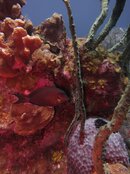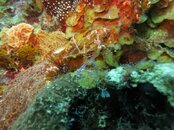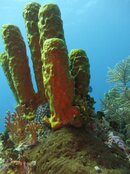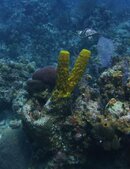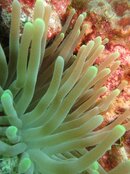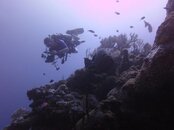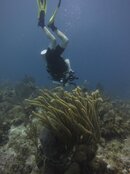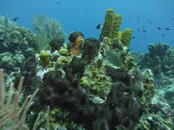bkopec
Contributor
First, thanks to those who helped with info in my s100 presets post (and to Kelli and Scott at Bluewater photo for answering several questions over email). I'll post a few pics soon, but I clearly don't know what I'm doing yet so hopefully my results will improve if I can get a few more questions answered.
I've read that the buttons on the Ikelite housing are a little stiff so I was prepared for this. Even so I felt like I had to press extremely hard to get some of the buttons to activate (this seemed to vary randomly both in and out of the water). I also experienced the problem of the buttons not activating at all. I tracked down a couple of forum posts w/ people complaining about the same thing and they seem to suggest the buttons can become locked down when the zoom is not in a neutral position. This doesn't make sense to me since that clearly doesn't happen w/ the camera outside of the case and I am positive that I was locked up even when the zoom wasn't touched at all. This was extremely annoying as it would randomly happen in the middle of my dives and keep me stuck in whatever setting I happened to be in (I wasn't changing settings much, but still got stuck w/ simple things like recording video and not being able to stop it, being stuck in or out of macro mode, flash on/off, white balance, etc.).
I had white balance set to ring function and it seemed to behave differently when I used my hand vs. a buddy's tank vs. the white sandy bottom. Sometimes the screen went red, sometimes black, sometimes light brownish. I wasn't too worried about this since I was shooting jpg and raw and planned to mess w/ white balance in post processing, but it was still frustrating to have it looking red and then have it get stuck and not be able to try to reset it at a different depth. Also, if I tried to do a quick video, it stayed red or whatever funky color it was locked into at the time (is it possible to adjust white balance of videos in post processing? That would definitely help).
For stills I was mostly using Av mode f5.6 - f8, iso100, flash on (the camera generally set shutter speed to 1/60). This was generally pretty solid whether I was in macro mode or not, although I did get a lot of "overly bright" shots (hot spots?) when shooting close (I was using a diffuser, but perhaps I need to reduce the flash power in those cases?). Most of the time I was unable to experiment with adjustments like this because my buttons were locked up. I also noticed that no matter how close I got (even just a few cm from a subject), w/ aperture at f8, I was unable to get the effect of having the subject in focus with a 'blurred' background. Is that possible w/out a macro lens?
For experimentation, I had my manual mode preset to f5.6, shutter 1/500 as many have suggested. Whether the flash was on or off, every picture in that mode came out essentially full black. A friend played w/ one in lighroom for a second and was able to get the black out and view the pic, but it still seems odd that it would do this. I must have a setting hosed up because even sitting here in the living room, I can change the shutter and aperture to essentially any combination of settings and I still get black pics.
Example pics coming soon, but hopefully you can help w/ my questions in the mean time. I definitely don't want to jump the gun and start considering a Recsea housing without fully understanding what's going on w/ my Ikelite.
Thanks!
Brian
I've read that the buttons on the Ikelite housing are a little stiff so I was prepared for this. Even so I felt like I had to press extremely hard to get some of the buttons to activate (this seemed to vary randomly both in and out of the water). I also experienced the problem of the buttons not activating at all. I tracked down a couple of forum posts w/ people complaining about the same thing and they seem to suggest the buttons can become locked down when the zoom is not in a neutral position. This doesn't make sense to me since that clearly doesn't happen w/ the camera outside of the case and I am positive that I was locked up even when the zoom wasn't touched at all. This was extremely annoying as it would randomly happen in the middle of my dives and keep me stuck in whatever setting I happened to be in (I wasn't changing settings much, but still got stuck w/ simple things like recording video and not being able to stop it, being stuck in or out of macro mode, flash on/off, white balance, etc.).
I had white balance set to ring function and it seemed to behave differently when I used my hand vs. a buddy's tank vs. the white sandy bottom. Sometimes the screen went red, sometimes black, sometimes light brownish. I wasn't too worried about this since I was shooting jpg and raw and planned to mess w/ white balance in post processing, but it was still frustrating to have it looking red and then have it get stuck and not be able to try to reset it at a different depth. Also, if I tried to do a quick video, it stayed red or whatever funky color it was locked into at the time (is it possible to adjust white balance of videos in post processing? That would definitely help).
For stills I was mostly using Av mode f5.6 - f8, iso100, flash on (the camera generally set shutter speed to 1/60). This was generally pretty solid whether I was in macro mode or not, although I did get a lot of "overly bright" shots (hot spots?) when shooting close (I was using a diffuser, but perhaps I need to reduce the flash power in those cases?). Most of the time I was unable to experiment with adjustments like this because my buttons were locked up. I also noticed that no matter how close I got (even just a few cm from a subject), w/ aperture at f8, I was unable to get the effect of having the subject in focus with a 'blurred' background. Is that possible w/out a macro lens?
For experimentation, I had my manual mode preset to f5.6, shutter 1/500 as many have suggested. Whether the flash was on or off, every picture in that mode came out essentially full black. A friend played w/ one in lighroom for a second and was able to get the black out and view the pic, but it still seems odd that it would do this. I must have a setting hosed up because even sitting here in the living room, I can change the shutter and aperture to essentially any combination of settings and I still get black pics.
Example pics coming soon, but hopefully you can help w/ my questions in the mean time. I definitely don't want to jump the gun and start considering a Recsea housing without fully understanding what's going on w/ my Ikelite.
Thanks!
Brian




